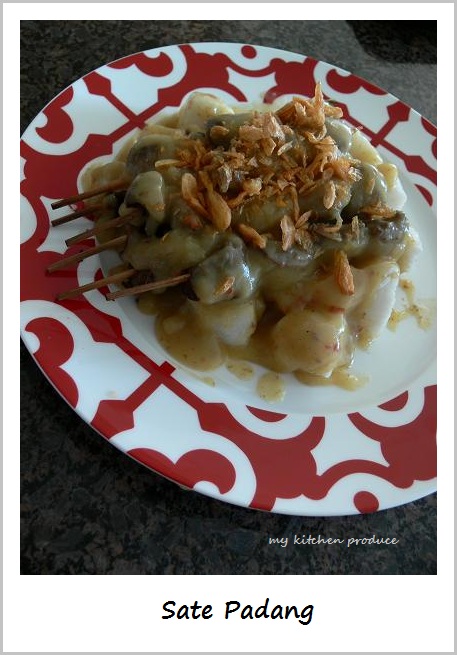Sate Padang
Sate Padang is originated from West Sumatra. The meat used to make the satay are taken from cow and buffalo, that includes some of the edible organs (not too sure what they are though) and possibly a non edible one (don’t wanna know what they are). The different between this particular satay and any other satay is that the meat and internal organs are marinated and boiled until tender and well done, then they are stuck in the bamboo skewer (traditionally they used the midrib of the coconut leaf). The satay then grilled on the charcoal and serve on top of banana leaves with thickened gravy sauce made from the stock of the marinated herb. They are best served with rice cake (known as ketupat) and topped off with fried shallot.
This is actually the first time I made this dish. I called my grandma from Indonesia to dig up some information since she was originated from Padang. I am not sure about other people’s grandmother. When my grandma explains about how to cook a dish, she never give me any measurement on how much each ingredients should be. So I always have to rely on my memory on how the dish should taste like. I still regret I didn’t really put so much of an interest while she was cooking before. Anyway, I didn’t want to fail as my husband also had the same craving as I was. I surfed the net and found some useful information.
According to my first effort on cooking this dish, I conclude that:
- Put little bit of salt when marinating and cooking the meat, as I didn’t. The meat flavours became bland if eaten by itself, well the gravy sure helps the flavour, but I think it is better to marinate and cook with the salt.
- Do not overcook the meat, because it is really hard to thin the meat and skewered them into the sticks as they tend to break. I ended up with a quite thick chunk of meat about 4 mm thick, where it supposed to be half the thickness.
- I found mine was not dry enough like the one sold in my hometown. But after a while, I realized that in my hometown, they sell this kind of satay using a cart, which they could push around the neighborhood and town. The skewered satay sticks are not wrapped in the cling wrap (they probably haven’t realized that there is this thing invented called cling wrap) or stored in a container. They are simply placed in an open shelf inside the cart(don’t even get me started about the hygienic issues), and that is probably the reason why the meat in the skewers dry up as they circle the town.
- Always topped of your Sate Padang with fried shallot. This is a must have as it could enhance the flavour.
Ingredients
- 1 kg gravy beef, cut into long strips
- 1 lemon grass, smashed
- 2 cm galangal, sliced and smashed
- 4 pcs lime leaves
- 4 pcs bay leaves
- 2 cm ginger, pureed
- 5 cloves garlic, pureed
- 5 cloves shallot, pureed
- 6 big red chillies, pureed
- 1 small red chilli, pureed
- 1 tbsp coriander powder
- 1 tsp cumin powder
- 1 tbsp turmeric powder or 5 cm of turmeric, pureed
- 1/2 tsp white pepper
- 1/2 sdt sugar
- 1 tbsp salt
- 500 ml of water, or just enough to cover the meat
- rice flour to thicken the gravy sauce
- satay stick
- rice cake to serve
- fried shallot to serve
Instructions
- Mix all ginger, garlic, shallot, chillies, coriander, cumin, turmeric, white pepper, sugar, and salt together. Marinate the beef strips for at least 1 hour.
- Cook the beef strips and all the marinade juices and herbs with lemon grass, galangal, lime leaves, bay leaves, and water over low medium heat until the beef is well done.
- Set aside the reserved liquid to make the gravy sauce later.
- Take out all the beef strips, slice it thinly and knock or roll it with the rolling pin. Stick them into the satay sticks.
- Grill them for few minutes until slightly brown. Preferably on the charcoal.
- For the sauce: Take the reserve liquid as needed and place them in a pan. Add some water, turmeric powder and salt. Add some rice flour to thicken the sauce. (I am sorry no measurement because I didn’t really measure this)
Preparation time (duration): 120
Culinary tradition: Indonesian
Please leave your comment/suggestion if you find this recipe useful. Can’t wait to hear from you and Thank You!!!







